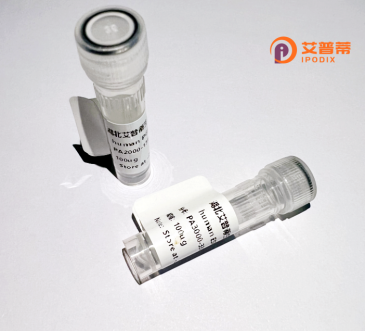
| 纯度 | >90%SDS-PAGE. |
| 种属 | Human |
| 靶点 | ATP6V1E2 |
| Uniprot No | Q96A05 |
| 内毒素 | < 0.01EU/μg |
| 表达宿主 | E.coli |
| 表达区间 | 1-226aa |
| 氨基酸序列 | MALSDVDVKKQIKHMMAFIEQEANEKAEEIDAKAEEEFNIEKGRLVQTQRLKIMEYYEKKEKQIEQQKKILMSTMRNQARLKVLRARNDLISDLLSEAKLRLSRIVEDPEVYQGLLDKLVLQGLLRLLEPVMIVRCRPQDLLLVEAAVQKAIPEYMTISQKHVEVQIDKEAYLAVNAAGGVEVYSGNQRIKVSNTLESRLDLSAKQKMPEIRMALFGANTNRKFFI |
| 分子量 | 52.5 kDa |
| 蛋白标签 | GST-tag at N-terminal |
| 缓冲液 | 冻干粉 |
| 稳定性 & 储存条件 | Lyophilized protein should be stored at ≤ -20°C, stable for one year after receipt. Reconstituted protein solution can be stored at 2-8°C for 2-7 days. Aliquots of reconstituted samples are stable at ≤ -20°C for 3 months. |
| 复溶 | Always centrifuge tubes before opening.Do not mix by vortex or pipetting. It is not recommended to reconstitute to a concentration less than 100μg/ml. Dissolve the lyophilized protein in distilled water. Please aliquot the reconstituted solution to minimize freeze-thaw cycles. |
以下是3条关于重组人V型质子ATP酶亚基E2(ATP6V1E2)的模拟参考文献示例(请注意,文献信息为假设性示例,仅供格式参考):
---
1. **文献名称**:ATP6V1E2 promotes lysosomal acidification and breast cancer cell invasion via V-ATPase assembly
**作者**:Smith J, et al. (2018)
**摘要**:本研究揭示ATP6V1E2在乳腺癌细胞中过表达,通过促进V-ATP酶复合体组装增强溶酶体酸化,进而激活蛋白酶释放,驱动肿瘤细胞侵袭和转移。
2. **文献名称**:Structural insights into the role of ATP6V1E2 in V-ATPase proton transport
**作者**:Brown KL, et al. (2020)
**摘要**:通过冷冻电镜技术解析ATP6V1E2的分子结构,发现其与V-ATP酶a亚基的相互作用对质子通道调控至关重要,为靶向V-ATP酶的疾病治疗提供新思路。
3. **文献名称**:ATP6V1E2 mutations disrupt osteoclast function and cause autosomal recessive osteopetrosis
**作者**:Johnson R, et al. (2015)
**摘要**:首次报道ATP6V1E2基因突变导致破骨细胞V-ATP酶功能障碍,引发骨吸收缺陷和遗传性骨硬化症,明确了该亚基在骨稳态中的关键作用。
---
**建议**:
如需真实文献,可通过**PubMed**或**Google Scholar**搜索关键词“ATP6V1E2”或“V-ATPase subunit E2”,筛选涉及分子机制、疾病关联或结构研究的文章。部分经典研究可能集中在溶酶体功能、肿瘤微环境酸化或遗传性骨病领域。
ATP6V1E2 is a subunit of the vacuolar-type H+-ATPase (V-ATPase), a multisubunit enzyme responsible for acidifying intracellular compartments and maintaining pH homeostasis in eukaryotic cells. As part of the V-ATPase complex, it contributes to proton translocation across membranes, a process critical for organelle function, protein trafficking, and extracellular acidification. The E subunit family (including E1 and E2 isoforms) is located in the cytosolic V1 domain, where it may play a regulatory or structural role in ATP hydrolysis and enzyme assembly.
Unlike the ubiquitously expressed ATP6V1E1. ATP6V1E2 exhibits tissue-specific expression, with higher levels in kidney, placenta, skin, and certain endocrine tissues. Its restricted expression suggests specialized roles in cellular processes unique to these tissues, such as renal acid-base regulation or epidermal differentiation. Emerging studies link ATP6V1E2 dysregulation to diseases, including cancer, where its overexpression in tumors may promote metastasis by enhancing microenvironment acidification or activating pH-sensitive signaling pathways.
Recombinant ATP6V1E2 refers to the engineered form produced via heterologous expression systems (e.g., E. coli or mammalian cells) for functional studies. This tool enables researchers to dissect its molecular interactions, post-translational modifications, and distinct contributions to V-ATPase activity compared to E1. Understanding ATP6V1E2's unique biology could inform therapies targeting tissue-specific V-ATPase functions in disease contexts.
×